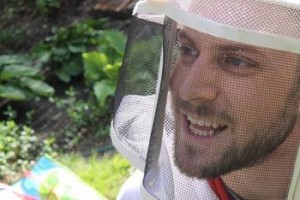 Even a graduate student working on a pressing, real-world problem needs diversions. Noah Wilson-Rich went to the Topsfield agricultural fair, an annual event in Essex County, Massachusetts and was drawn to the Bee House with its observational hives. Local honey was on sale, and apiarists were on hand to talk about what they do. The young entomologist—whose knowledge about insects had so far come largely from textbooks—put his name on the sign-up sheet for a beekeeping course. Before long, he was a certified beekeeper.
Even a graduate student working on a pressing, real-world problem needs diversions. Noah Wilson-Rich went to the Topsfield agricultural fair, an annual event in Essex County, Massachusetts and was drawn to the Bee House with its observational hives. Local honey was on sale, and apiarists were on hand to talk about what they do. The young entomologist—whose knowledge about insects had so far come largely from textbooks—put his name on the sign-up sheet for a beekeeping course. Before long, he was a certified beekeeper.